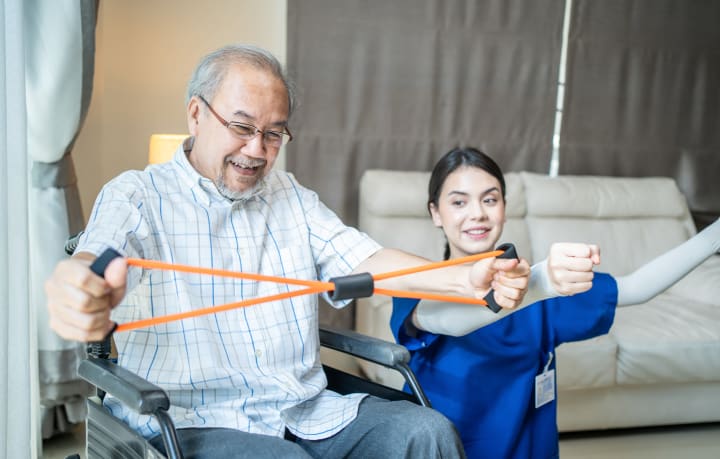Continuing Care Retirement Communities Explained
Are you asking, “What is a continuing care retirement community (CCRC)?”
We’ve got you covered because (let’s be honest)…
It can be difficult for seniors and their families to find the right senior living option.
We’ll discuss what it is in this article, as well as the benefits of your loved one living in a continuing care retirement center.
Table of Contents
- What is a Continuing Care Retirement Community (CCRC)?
- What is the Purpose of a Continuing Care Community?
- How Does a Continuing Care Retirement Community Work?
- What Levels of Care Do Continuing Care Retirement Communities Offer?
- Understanding 3 Common Continuing Care Retirement Community Contracts
- Pros and Cons of Continuing Care Retirement Communities
- Alternatives to Continuing Care Retirement Communities
- Explore Assisted Living Options With Senior Services of America
What Is a Continuing Care Retirement Community (CCRC)?
A continuing care retirement community (CCRC) is a senior living option that provides seniors with the opportunity to “age in place”, or live in one location for as long as they need.
These communities typically offer …
- Independent and assisted living options
- On-site healthcare services
- 24/7 access to doctors and nurses
… so residents can choose what level of help they want through the various stages of the aging process.
Continuing care retirement communities are designed to meet all your needs: you don’t have to move into an assisted living facility when you require more assistance in the future.
What Is the Purpose of a Continuing Care Community?
The main purpose of a continuing care retirement community is to offer seniors the opportunity to live in one location for as long as needed.
This allows families and residents peace of mind, knowing that loved ones will have all the support they require no matter their ongoing needs.
Continuing care retirement communities are designed with all levels of care in mind.
Residents don’t have to worry about what living arrangements they will need when their needs change because the community can provide them with what’s necessary.
How Does a Continuing Care Retirement Community Work?
A continuing care retirement community is a one-stop-shop for all your senior needs.
The design of continuing care retirement communities allows seniors to move from independent living (needing little assistance) to assisted living (needing more help with daily tasks and medical needs).
For example, if a resident requires more assistance than what is available in the independent living section of the community, they can choose to upgrade their accommodations and move into an area with higher levels of care.
This ensures that residents will never have to leave this type of continuing care senior living as their needs change over time.
What Levels of Care Do Continuing Care Retirement Communities Offer?
- Level 1: Independent living: This is generally the first stage in a resident’s life at their continuing care retirement community. Older adults who are active and healthy enjoy the continuing care retirement community facilities and maintenance-free advantages while living alone in their preferred home.
- Level 2: Assisted living: If a loved one’s level of care requires greater assistance, assisted living can provide round-the-clock custodial and medical services. Staff members are available to assist with activities of daily living, such as bathing, dressing, or medication administration, for residents to be as independent as possible. Assisted living may be provided in the form of apartment-style housing, either entirely private or semi-private.
- Level 3: Memory care: Seniors who are experiencing memory loss as a result of dementia, Alzheimer’s disease, or other cognitive disabilities may choose to move to the on-campus memory care facility at the continuing care retirement community. Residents are cared for by specially trained staff who prioritize comfort, engagement, and safety.
- Level 4: Skilled nursing care: Skilled nursing care, like assisted living, involves medical and custodial services 24 hours a day, seven days a week. However, skilled nursing pertains specifically to rehabilitation services and short-term care. For instance, residents requiring post-surgical wound treatment, physical or speech therapy following a stroke, or IV medication administration might stay in the skilled nursing facility of a community care retirement complex.

Understanding 3 Common Continuing Care Retirement Community Contracts
You will need to consider some basic contract questions when considering a continuing care retirement community, such as:
- What is the cost structure, and will fees be updated frequently?
- What are the current costs and how much will they rise in future years?
- What are the payment arrangement options?
- What services are provided as part of the entrance fee, and how much does it cost?
- What are the additional fees for services that aren’t covered by the standard fees?
- What happens if one partner requires greater care than the other after you’ve moved in as a couple?
- What if there are no vacancies in assisted living or nursing care, but a resident requires help with daily activities?
- Are any of a resident’s fees refunded to the estate when he or she passes away?
- Is there any cost to get out of a community? Is it possible to get a refund if a resident decides to leave?
In addition to these questions, understanding the following three common contracts can help you better decide what works best for your loved one and your family’s unique situation.
#1: Extensive Life-Care Contract
An extensive life-care contract goes with what you generally think of as a continuing care retirement community. In this type of complex, residents sign an agreement that guarantees access to different levels of care for the duration of their lives.
In return, the continuing care retirement community agrees to provide these services at no additional cost from what was paid when they first moved into the community — even if financial resources are depleted later on through unforeseen circumstances.
What Is a “Type A” Continuing Care Retirement Community?
A “Type A” continuing care retirement community is where a lengthy life-care contract, which is also known as an extensive life-care agreement, is honored. This plan has the highest costs but will provide comprehensive services.
#2: Modified Contract
A modified contract, sometimes known as a Type B plan, restricts residents only to prepaying for part of future medical treatment.
When more care is required, the monthly service charge may go up.
A modified contract, for example, may only cover a portion of the care cost if a resident needs totransition from independent living to skilled nursing.
#3: Fee-for-Service Contract
The fee-for-service contract includes an upfront entrance fee and monthly service fee that are often the most cost-effective.
Residents pay for medical expenses as they occur instead of paying for all medical expenditures under an extensive life care contract or a portion of medical costs under a modified agreement.
Assisted living or memory care are examples of services that incur a fee-for-service cost.
Pros and Cons of Continuing Care Retirement Communities
Moving into a continuing care retirement community can be an important step in ensuring your loved one’s comfort and security.
However, what works for some people may not work for the potential resident.
It’s important to consider what your family needs so you can make an informed decision about whether a continuing care retirement community is best for your family.
Security
A continuing care retirement community provides peace of mind and security for your family.
Care is available around the clock, giving you and your loved ones complete freedom to live on-site without worrying about what will happen if medical needs exceed what can be handled in an assisted living facility.
Cost
The main advantage of continuing care retirement communities is that they provide …
- A variety of care, services, and activities in one location; and
- A feeling of stability and familiarity for residents
… as their abilities or health issues change.
However, there is a cost to this that typically exceeds what you might pay for other alternatives to continuing care retirement communities.

Alternatives to Continuing Care Retirement Communities
While continuing care retirement communities offer many benefits, they also come with some challenges that may not be worth it for every family.
Here are some alternatives to continuing care retirement communities that can be considered when exploring your options:
- Your own home with the help of caregivers
- A retirement community that has services for seniors on-site
- Senior villages which offer independent living and communal activities like bingo or yoga classes
- An assisted living facility where you can live independently but still have access to care when needed
Assisted Living Communities
If you are concerned about the ability to “age in place” by benefiting from varying levels of care, an assisted living community can also be a great solution.
Oftentimes, residents need care in the later stages of life and would benefit more from an assisted living community than a continuing care retirement community.
Assisted living communities can also accommodate a wide range of residents.
For example, a resident may begin living in assisted living with the ability to take care of himself but have the security of knowing they can “age in place” as they may need more increasing care over time.
As you can see, assisted living communities are an important option that should be considered when looking for senior living solutions.
Because what works best for one family may not work well in another situation, the advisors at Senior Services of America communities can help families make informed decisions about how senior housing, such as assisted living, can fit their needs.
Explore Assisted Living Options With Senior Services of America
Are you looking for assisted living options for your loved one?
Senior Services of America communities offer assisted living options with the goal of helping seniors live their best lives by providing them with the highest quality service possible.
You can rest easy knowing that our team will be there for your family every step of the way as you transition into one of our facilities.
We’ll make sure everything runs smoothly so that you can focus on what matters most – enjoying life to the fullest.
Let us help you take care of everything so that you don’t have to worry. Find your nearest community to speak to one of our advisors today.